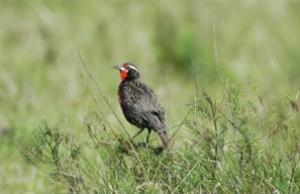Adrián Azpiroz
Other projects
29 Aug 2008
Pampas Meadowlark: Using a Flagship Species to Promote Conservation in the South American Grasslands I
7 Sep 2010
Pampas Meadowlark: Using a Flagship Species to Promote Conservation in the South American Grasslands II
9 Oct 2013
Pampas Meadowlark: Using a Flagship Species to Promote Conservation in South American Grasslands III
12 Aug 2015
Pampas Meadowlark: Using a Flagship Species to Promote Conservation in South American Grasslands IV
The specific objectives are:
1) to determine grassland bird community composition in altered and undisturbed grassland habitats.
2) to identify species-habitat associations for grassland birds; and
3) to determine differences in nesting success among habitats for species that occur in different altered and undisturbed grassland types. Research activities will be coupled with an educational campaign aimed to increase public awareness in the study areas.

Habitat loss is the most important proximate factor causing current avian population declines worldwide. In the Neotropics, grasslands are one of the most vulnerable ecosystems, as almost no pristine grasslands remain anywhere in this region, and all are threatened to some degree. The Pampas grasslands of south-eastern South America, harbour a rich avifauna represented by 110 grasslands species. The Pampas have very favourable conditions for farming, and accordingly, a huge agricultural expansion began in the late XIX century. This has resulted in conversion of large areas to cropland, replacement of tall grass by short grass communities, and introduction of exotic plant species. Today, agriculture is widespread and undisturbed grasslands are largely restricted to a few protected areas. The loss of pristine habitats has caused population reductions of many birds, and 15 species are considered of global conservation concern, including several endemic birds.
Even though South American grasslands and their threatened avifauna have been highlighted as research and conservation priorities, grassland bird research in the Western Hemisphere, has concentrated largely in North America. In the Pampas, in contrast, only limited research has been conducted and conservation action targeting grassland birds has been almost non-existent. One factor limiting conservation is a general lack of ecological information. The general objective of this project is to provide a sound understanding of the ecology of Pampas´ birds inhabiting both altered and natural grassland habitats and to apply this knowledge to specify management guidelines aiming to improve the birds’ conservation status.